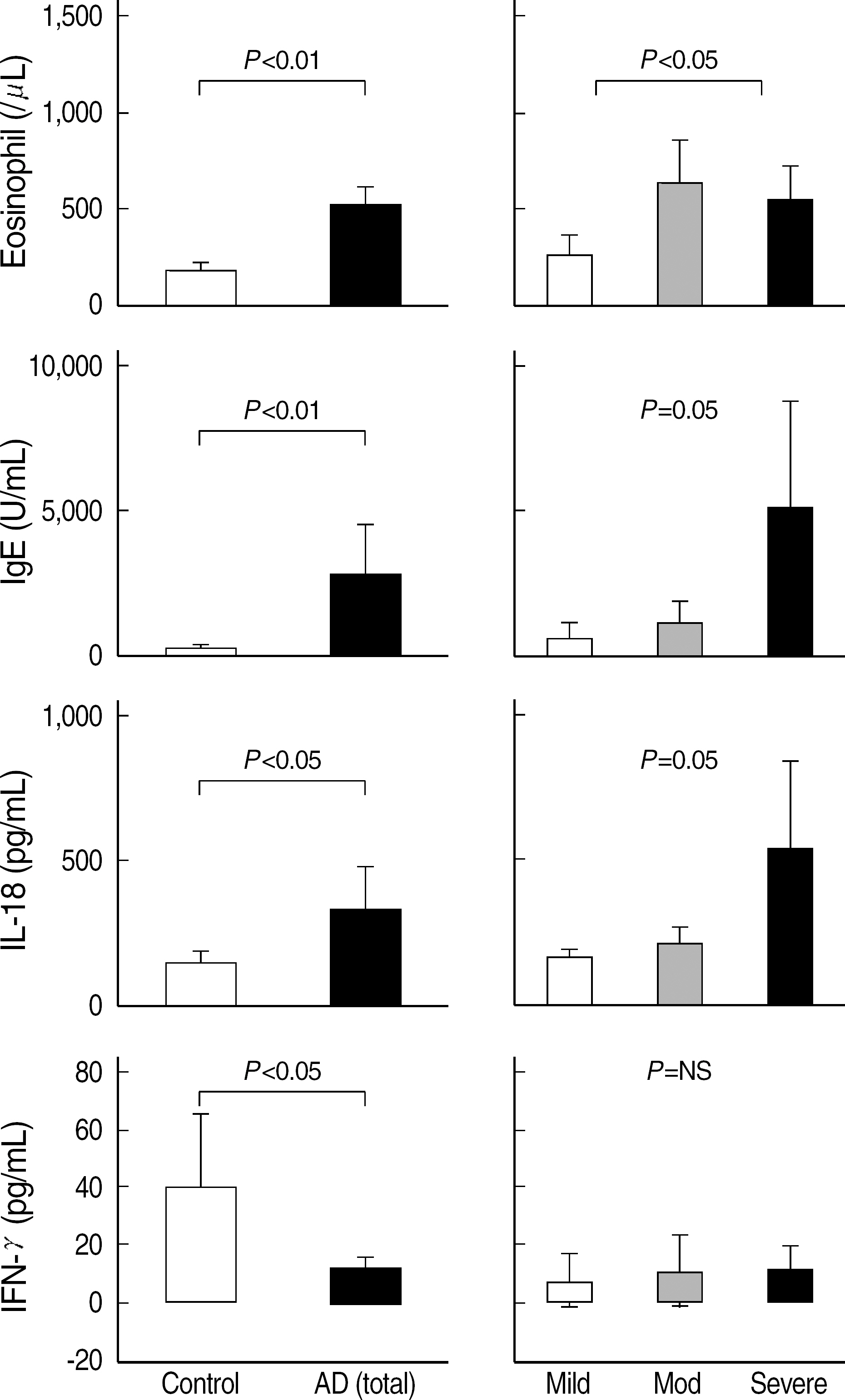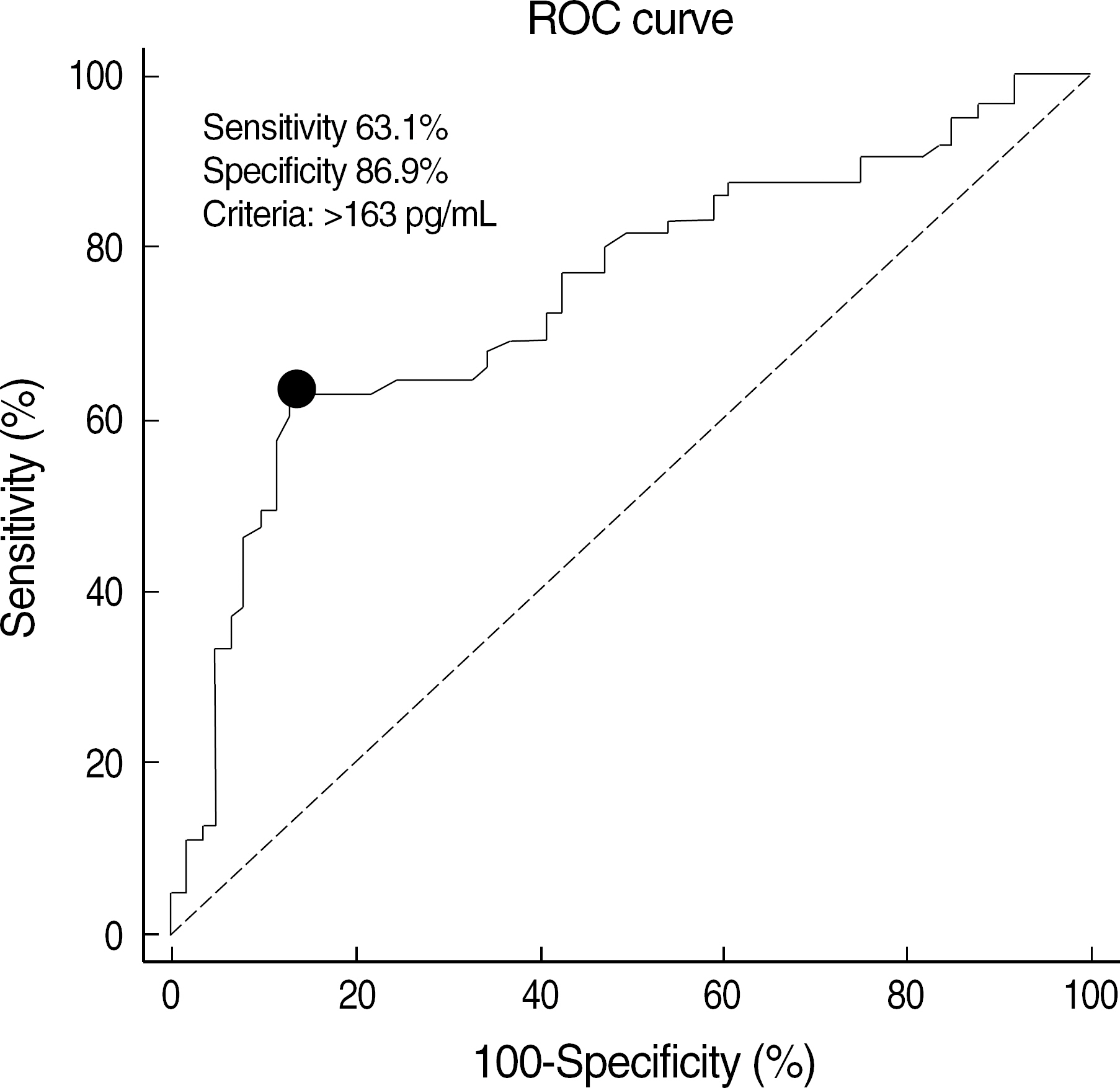Korean J Lab Med.
2007 Apr;27(2):128-132. 10.3343/kjlm.2007.27.2.128.
Clinical Significance of Serum Interleukin-18 Concentration in the Patients with Atopic Dermatitis
- Affiliations
-
- 1Department of Laboratory Medicine, School of Medicine, Wonkwang University, Iksan, Korea. email@wonkwang.ac.kr
- 2Department of Dermatology, School of Medicine, Wonkwang University, Iksan, Korea.
- 3Institute of Wonkwang Medical Science, School of Medicine, Wonkwang University, Iksan, Korea.
- KMID: 1781472
- DOI: http://doi.org/10.3343/kjlm.2007.27.2.128
Abstract
- BACKGROUND: Interleukin (IL)-18, a potent inducer of interferon gamma (IFN-gamma), is known to have a role in diseases involving type-2 T helper cell responses including atopic dermatitis. In this study, we aimed to determine the clinical significance of serum IL-18 level in the patients with atopic dermatitis. METHODS: Serum concentration of IL-18, IFN-gamma, IgE, and blood eosinophil were measured in the patients with atopic dermatitis and healthy control subjects, and their association with the clinical score of the disease was analysed. RESULTS: Serum concentrations of IL-18 were significantly elevated in patients with atopic dermatitis compared to the healthy controls (332 pg/mL vs 151 pg/mL, P<0.05). Serum levels of IL-18 (r=0.41, P=0.001), eosinophil (r=0.36, P=0.003), and IgE (r=0.32, P=0.009) correlated with clinical scores in the patients. Also, multiple regression analysis indicated that serum IL-18 and IgE levels were independent predictors for the clinical score of atopic dermatitis (r2=0.25, beta=0.39, P=0.001 and beta=0.32, P=0.009). CONCLUSIONS: Our results confirmed a significant correlation between the concentration of serum IL-18 and the severity of atopic dermatitis. Although serum IL-18 concentration reflects the disease severity, its usefulness as a clinical test needs to be further investigated, because its additive benefit over those of conventional blood tests is not evident so far.
Keyword
MeSH Terms
Figure
Reference
-
References
1. Okamura H, Tsutsui H, Kashiwamura S, Yoshimoto T, Nakanishi K. Interleukin-18: a novel cytokine that augments both innate and acquired immunity. Adv Immunol. 1998; 70:281–312.
Article2. Billiau A. Interferon-gamma: biology and role in pathogenesis. Adv Immunol. 1996; 62:61–130.3. Xu L, Rothman P. IFN-gamma represses epsilon germline transcription and subsequently down-regulates switch recombination to epsilon. Int Immunol. 1994; 6:515–21.4. Pizarro TT, Michie MH, Bentz M, Woraratanadharm J, Smith MF Jr, Foley E, et al. IL-18, a novel immunoregulatory cytokine, is up-regulated in Crohn's disease: expression and localization in intestinal mucosal cells. J Immunol. 1999; 162:6829–35.
Article5. Gracie JA, Forsey RJ, Chan WL, Gilmour A, Leung BP, Greer MR, et al. A proinflammatory role for IL-18 in rheumatoid arthritis. J Clin Invest. 1999; 104:1393–401.
Article6. Nakanishi K, Yoshimoto T, Tsutsui H, Okamura H. Interleukin-18 regulates both Th1 and Th2 responses. Annu Rev Immunol. 2001; 19:423–74.
Article7. Izakovicova Holla L. Interleukin-18 in asthma and other allergies. Clin Exp Allergy. 2003; 33:1023–5.
Article8. Chang TT, Stevens SR. Atopic dermatitis: the role of recombinant interferon-gamma therapy. Am J Clin Dermatol. 2002; 3:175–83.9. Kang K, Stevens SR. Pathophysiology of atopic dermatitis. Clin Dermatol. 2003; 21:116–21.
Article10. Wild JS, Sigounas A, Sur N, Siddiqui MS, Alam R, Kurimoto M, et al. IFN-gamma-inducing factor (IL-18) increases allergic sensitization, serum IgE, Th2 cytokines, and airway eosinophilia in a mouse model of allergic asthma. J Immunol. 2000; 164:2701–10.11. Konishi H, Tsutsui H, Murakami T, Yumikura-Futatsugi S, Yamanaka K, Tanaka M, et al. IL-18 contributes to the spontaneous development of atopic dermatitis-like inflammatory skin lesion independently of IgE/stat6 under specific pathogen-free conditions. Proc Natl Acad Sci USA. 2002; 99:11340–5.
Article12. Yoshizawa Y, Nomaguchi H, Izaki S, Kitamura K. Serum cytokine levels in atopic dermatitis. Clin Exp Dermatol. 2002; 27:225–9.
Article13. Hon KL, Leung TF, Ma KC, Wong CK, Wan H, Lam CW. Serum concentration of IL-18 correlates with disease extent in young children with atopic dermatitis. Pediatr Dermatol. 2004; 21:619–22.
Article14. Aral M, Arican O, Gul M, Sasmaz S, Kocturk SA, Kastal U, et al. The relationship between serum levels of total IgE, IL-18, IL-12, IFN-gamma and disease severity in children with atopic dermatitis. Mediators Inflamm. 2006; 2006:73098.15. Hanifin JM, Rajka G. Diagnostic features of atopic dermatitis. Acta Derm Venererol. 1980; 92:44–7.16. Stadler JF. Severity scoring of atopic dermatitis: the SCORAD index. Consensus Report of the European Task Force on Atopic Dermatitis. Dermatology. 1993; 186:23–31.17. Tanaka T, Tsutsui H, Yoshimoto T, Kotani M, Matsumoto M, Fujita A, et al. Interleukin-18 is elevated in the sera from patients with atopic dermatitis and from atopic dermatitis model mice, NC/Nga. Int Arch Allergy Immunol. 2001; 125:236–40.
Article18. El-Mezzein RE, Matsumoto T, Nomiyama H, Miike T. Increased secretion of IL-18 in vitro by peripheral blood mononuclear cells of patients with bronchial asthma and atopic dermatitis. Clin Exp Immunol. 2001; 126:193–8.
Article19. Yoon DY, Lee KA, Park JK, Kim JW. Determination and significance of serum Interleukin-18 levels in patients with chronic hepatitis B virus infection. Korean J Lab Med. 2004; 24:139–45.
- Full Text Links
- Actions
-
Cited
- CITED
-
- Close
- Share
- Similar articles
-
- Characteristic Clinical Features of Korean Atopic Dermatitis Patients with Interleukin-17 Receptor A Gene Mutation
- Serum IgE Level in Patients of Atopic Dermatitis and Atopic Dermatitis with Molluscum Contagiosum
- Serum Levels of Soluble CD30 in Childrens with Atopic Dermatitis
- Total Serum IgE Level in Each Age Group of Patients with Atopic Dermatitis
- Correlation between serum 25-hydroxyvitamin D levels and severity of atopic dermatitis in children



